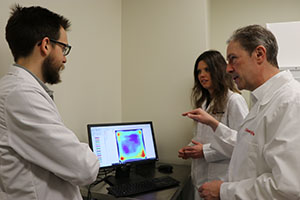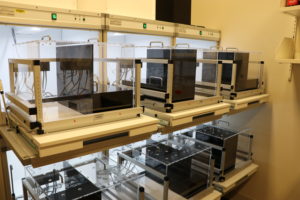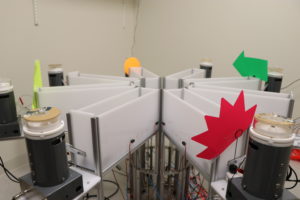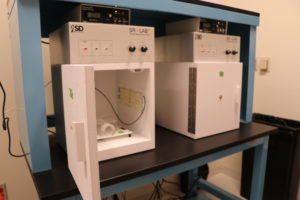 The Indiana University School of Medicine Behavioral Phenotype Core (BPC) is a new resource for investigators to expand their research scope to include rodent behavior and in vivo physiology in their work. David McKinzie, PhD, is the director of the BPC.
The Indiana University School of Medicine Behavioral Phenotype Core (BPC) is a new resource for investigators to expand their research scope to include rodent behavior and in vivo physiology in their work. David McKinzie, PhD, is the director of the BPC.
“Say you’re in medical genetics and you have a new mutant animal model,” said McKinzie. “It’s the first of its kind. We can take those mice and do broad characterizations, look at consummatory behaviors, as well as locomotor, motor and sensory behaviors. We can also look at some of the more subtle cognitive function that exists.”

The core is housed in the Stark Neurosciences Research Institute, so some of the work already being done there is focused on Alzheimer’s disease, but they have also helped investigators who are studying addictions, brain insults, pain and diabetes. They have developed several assays to help them look at a variety of sensory, motor, and cognitive indicators, which can signal differences in the underlying physiology of the animal. Some of the equipment includes video tracking and home-cage telemetry, which can help researchers see patterns in behavior over time.
In addition to providing behavioral assays, the core also helps train graduate students and post-docs on implementation of sound experimental design for behavioral studies and to use specific equipment. McKinzie says he hopes to be able to support education and training more in the future, especially to help with reproducibility.
 As the core grows, McKinzie says they have revised their assays based on their collaborations. One of their goals for 2020 is to reach out to investigators in other areas, such as oncology and musculoskeletal groups.
As the core grows, McKinzie says they have revised their assays based on their collaborations. One of their goals for 2020 is to reach out to investigators in other areas, such as oncology and musculoskeletal groups.
 “Behavior of rodents can really be applied across any therapeutic area,” said McKinzie. “One of the things we want to do is take the behavior and try to, in that same animal, correlate it back to whatever your disease endpoint is. If you’re looking at diabetes, how does this correspond to glucose or insulin control? Or if you’re looking at cognitive effects, you can look at markers of metabolic dysfunction in the brain. That’s the goal, to work deeply with these individual labs to be a supplement, to help IU School of Medicine researchers have that additional multidisciplinary component that will help them publish in higher tier papers and also lead to more grant funding.”
“Behavior of rodents can really be applied across any therapeutic area,” said McKinzie. “One of the things we want to do is take the behavior and try to, in that same animal, correlate it back to whatever your disease endpoint is. If you’re looking at diabetes, how does this correspond to glucose or insulin control? Or if you’re looking at cognitive effects, you can look at markers of metabolic dysfunction in the brain. That’s the goal, to work deeply with these individual labs to be a supplement, to help IU School of Medicine researchers have that additional multidisciplinary component that will help them publish in higher tier papers and also lead to more grant funding.”
The Behavioral Phenotype Core is available to all IU School of Medicine investigators, with plans to expand to support the broader Indiana Clinical and Translational Sciences Institute (CTSI) network.
For more information, email David McKinzie.
